Have you ever wondered how retail giants always seem to be two steps ahead? It’s not just about having deep pockets but smartly investing in digital transformation in the retail industry.
While 80% of shoppers use a smartphone inside a physical store, can you really afford to ignore digital retail innovation?
Digital transformation in retail is equal to getting a high-tech makeover to your business, be it clothing, electronics, drugs, beauty, convenience, or department stores. It’s like moving from a comfy old sofa to a state-of-the-art massage chair – both serve the same purpose, but the experience is worlds apart!
Why Digital Transformation?
Well, it’s simple. The benefits of digital transformation in retail are too juicy to ignore. Imagine understanding your customer’s needs before they even walk into your store. That’s not magic; it’s data analytics at play.
But where to start? Retail digitalization isn’t just about slapping a screen here and there. It’s about strategically embedding technology into every facet of your business. From AI-driven recommendations to IoT in inventory management – the possibilities are endless.
So, ask yourself: Are you just keeping up with the times, or are you setting the pace for the future? In the race for retail digital transformation, it’s more about running smart than just running.
Let this guide be your compass in the journey of your retail transformation. Get in your researcher mode and ready to plan the Digital Transformation strategy for your retail business.
What does Digital Transformation in Retail mean?
Digital transformation in retail simply means using digital technologies to enhance and modernize your business operations and customer interactions. If we were to break it down, it’s integrating digital tools, such as online shopping platforms, mobile apps, and data analytics, into the retail experience to improve customer satisfaction, streamline operations, and drive business growth.
For example, a traditional brick-and-mortar retail store implementing digital transformation might create an e-commerce website where customers can browse and purchase products online. Using customer relationship management (CRM) software to better understand customer preferences and tailor marketing efforts is also part of retail digitization. Even introducing in-store digital displays or mobile payment apps to enhance the overall shopping experience, making transactions more seamless is a digital transformation in retail.
Now, when you digitize your retail business, you must focus on the following four areas as they are at the center of the digital transformation.
4 Main Areas of Digital Transformation in the Retail Industry
Since transformation means change in nature, form, or process, digital transformation in the retail industry serves as a paradigm shift. The transformation process touches core aspects of the retail business, making it customer-centric, competitive, and ready for the future. So, let us see what are the core aspects you must focus on while undergoing a digital transformation.
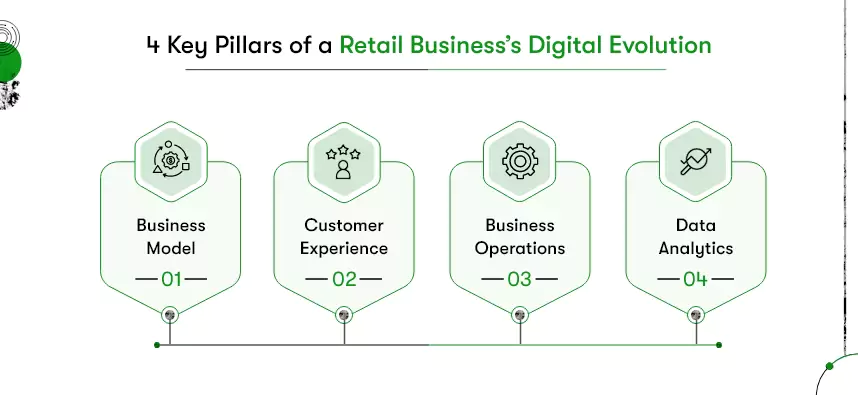
Business Model:
Business Model is like a caterpillar turning into a butterfly – complete metamorphosis! Digital transformation redefines how you sell, turning brick-and-mortar stores into omnichannel experiences.
Take the example of the online marketplace, Amazon’s transformation from a bookstore to a one-stop shop for various products.
What you should consider:
- Identify new revenue streams, such as subscription services or digital content.
- Adopt an omnichannel approach to reach customers across various platforms and devices.
- Evaluate partnerships with technology companies to enhance the business model.
Customer Experience:
The customer experience undergoes a radical transformation during retail digitization, enhancing customer satisfaction and the brand’s reputation. Moreover, leveraging technologies like AI, virtual reality, and augmented reality allows you to innovate every touchpoint where your customers engage with your retail brand.
For example, using AR fitting rooms, retailers like Adidas and ASOS let their buyers digitally try on the items before buying.
What you should consider:
- Invest in user-friendly interfaces for websites and mobile apps.
- Use AI, ML, and AR/VR technologies to increase customer engagement.
- Harness customer data to tailor marketing campaigns and product offerings.
- Provide multiple touchpoints for customer support, such as chatbots and social media.
Business Operations:
When you use modern technologies for Digital transformation in retail, it revolutionizes operations fundamentally. From inventory management with IoT to efficient supply chains with blockchain, it makes doing more with less and doing it faster.
For example, using inventory management software to optimize stock levels and reduce holding costs.
What you should consider:
- Automate repetitive tasks through Robotics Process Automation or AI-driven systems.
- Integrate supply chain management tools for real-time visibility and coordination.
- Train and upskill employees to adapt to new digital tools and processes.
Data Analytics:
Data is the secret sauce of successful retail digitization. By channeling technologies like Big Data and Data Analytics, you can understand customer behavior, predict market trends, and make data-driven decisions. In other words, you can turn data into actionable insights, staying ahead of the curve.
For example, by analyzing data, retailers can forecast demand and optimize pricing strategies.
What you should consider:
- Ensure data security and compliance with regulations such as GDPR.
- Implement advanced analytics techniques, such as machine learning, for deeper insights.
- Establish a data-driven culture within the organization to make informed decisions.

Challenges faced by Brands during Retail Digital Transformation
Starting the digital transformation journey in retail can often feel like preparing for a marathon. It’s exciting and holds immense potential, but it’s also laden with obstacles that can trip you up. Let’s take a closer look at these challenges and how you can skillfully navigate them as a retail leader.
Resistance to Change: The Familiar Anchor
Firstly, let’s address the elephant in the room: resistance to change. It’s human nature to cling to the familiar, right? But remember, a ship in the harbor is safe, but that’s not what ships are built for. Overcome this by fostering a culture that embraces change. Engage your team, communicate the vision, and lead by example.
Integrating New Technologies: The Puzzle
Integrating new technologies is like solving a complex puzzle. With 70% of digital transformations failing, mostly due to a lack of employee engagement, the challenge is real. The key? Start small, pilot projects to build confidence, and gradually scale up.
Data Security: Navigating the Digital Sea with Caution
In this digital age, data security is paramount. A breach can sink your ship! Investing in robust cybersecurity measures and training your crew (employees) in data hygiene are non-negotiable steps.
Keeping Up with Rapid Technology Changes:
The Race Against Time Technology evolves at the speed of light. Keeping up can feel like chasing the horizon. Continuous learning and innovation are your best mates here. Stay curious, stay informed.
Budget Constraints: The Wind in Your Sails
Finally, budget constraints. Yes, digital transformation requires investment, but it’s about spending smart, not just spending big. Prioritize initiatives that offer the most value and track ROI diligently.
Benefits of Digital Retail Transformation for types of brands
Thinking about why retailers need to redefine their businesses using technologies and adopt digitization? What benefits can this digital transformation offer to your retail business? Well, retail digitization is a complete overhaul of how retail businesses operate and engage with customers. And the following benefits are the reason why most retail companies adopt digitization.
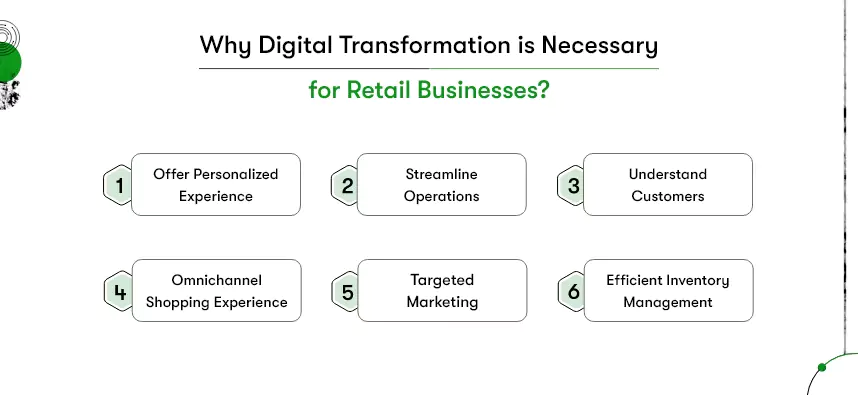
Crafting Personalized Shopping Journeys
Digital transformation enables retailers to offer highly personalized shopping experiences like Amazon’s tailored product recommendations. This is achieved by integrating AI and data analytics into retail operations, allowing a deeper understanding of customer preferences and behaviors. Retail apps further personalize the experience by offering features like virtual try-ons and customized product suggestions.
Streamlining Operations with Smart Tech
Adopting technologies like RFID for inventory management, as seen in Zara’s operations, exemplifies how digital transformation optimizes retail operations. These technologies streamline processes, reduce manual effort, and improve supply chain efficiency, leading to significant cost savings and operational agility.
Deciphering the Customer Behavior
Retailers gain profound insights into customer behavior by utilizing AI and big data analytics. This transition to a data-driven approach helps create more effective marketing strategies, improve product offerings, and understand market trends and customer needs more accurately.
Seamless Shopping Across All Fronts
Digital transformation facilitates omnichannel strategies, ensuring a cohesive shopping experience across online, in-store, and mobile app channels. This not only increases customer retention but also meets the modern consumer’s expectation for seamless interaction across different shopping platforms.
Smarter Processes, Bigger Gains
By automating various processes in retail, from customer service to inventory management, digital transformation reduces manual errors and increases efficiency. Consequently, this leads to cost savings and allows staff to focus on more strategic tasks.
Retail App Development as a Transformation Tool
Mobile apps for retail businesses are a cornerstone of digital transformation in retail. Retail app development provides businesses with rich customer data, enabling personalized marketing to improve the shopping experience. They are a direct link to the consumers, offering a platform for engagement, feedback, and loyalty building.
Targeted Marketing with Data Insights
Digital transformation equips retailers with the tools to analyze customer data for targeted marketing. The approach, supported by CRM and marketing automation technologies, results in more effective marketing campaigns that resonate with the target audience and adapt to changing consumer behaviors.
Simplified Inventory Management
Digital technologies enable more efficient inventory management, allowing retailers to track stock levels in real-time, predict demand more accurately, and reduce the likelihood of overstocking or stockouts. Consequently, retailers can respond quickly to market changes and customer demands.
Technology Trends Driving Digital Retail Transformation
As we delve into the technology trends driving digital retail transformation, let’s unpack how these trends are not just reshaping retail but also offering new avenues for customer engagement and operational efficiency.
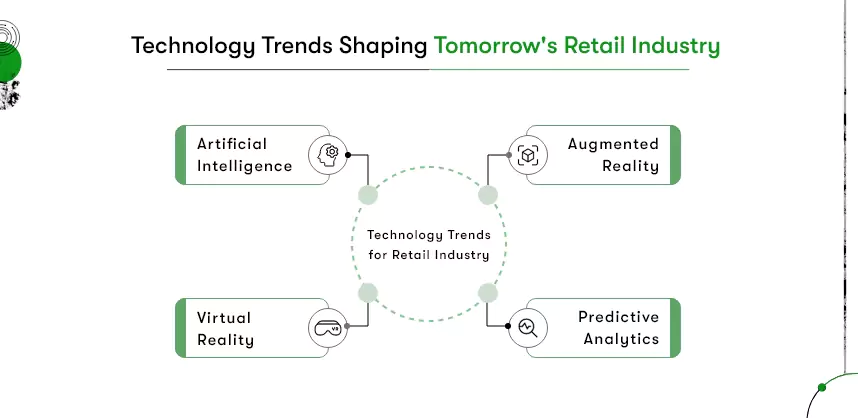
Artificial Intelligence (AI)
Artificial Intelligence in Retail is revolutionizing the retail landscape by personalizing customer experiences and streamlining operations. Retailers leverage AI for various applications like customer service chatbots, personalized product recommendations, and demand forecasting.
For example, The Home Depot uses AI to build audience segments from its 170 million profiles, increasing personalized campaigns by 62% year-over-year. This approach not only benefits customers through tailored experiences but also empowers staff with enhanced skills and opportunities for growth.
Augmented Reality (AR) and Virtual Reality (VR)
AR and VR technologies extend beyond gaming into retail, offering customers unique digital experiences. Allowing customers to try on products virtually, AR/VR increases the likelihood of purchases, offering personalized recommendations in a digital environment.
Augmented and virtual reality is relevant for today’s varied shopping contexts – at home, on the go, and in-store. For instance, AR shopping is enabling customers to engage with brands and products through digital experiences that are both interactive and immersive.
Predictive Analytics
From forecasting demand, customer behavior, and pricing to optimizing supply chains, predictive analytics is helping retailers optimize their operations and improve the customer experience. Predictive analytics uses historical data and machine learning algorithms to forecast demand, assisting retailers to anticipate shifts in consumer preferences and external factors that may affect demand.
How do you plan for digital transformation in retail?
According to Deloitte,
70% of transformation efforts fail, and it takes around three years for organizations to begin competing in the digital market, even when they get it right.
Further, the report confirms that at the core of most failures is not the technology but a lack of urgency and clarity, “where to start,” and a fear of change. So, where do you start? What technology should you choose? And how do you ensure it aligns with your retail vision?
Let’s take a look at the key areas you should focus on for your retail transformation.
Assess and Identify Your Needs:
Ever felt like you’re playing catch-up with the digital world? It’s time to take stock of where your retail business stands in the digital landscape. Assess your current processes, customer interactions, and pain points. Understand what digital retail innovation can solve these issues. The goal? To pinpoint exactly what your business needs to leap into the digital age.
Define Your Digital Strategy:
What does digital success look like for you? It’s not just about going digital; it’s about doing it right. This step involves setting clear objectives for your digital transformation in retail. Whether enhancing customer experience, streamlining operations, or boosting sales, your strategy should align with your business goals.
Choose the Right Technology
Fluttering thoughts on what tech to choose? When it comes to building retail apps, Flutter App Development stands out. It’s about choosing a tech stack that’s versatile, scalable, and user-friendly. Why Flutter? It offers a seamless experience across multiple platforms, which is crucial in today’s omnichannel retail world.
Implement and Integrate
Ready to dive into the digital deep end? Implement your chosen technologies thoughtfully. It’s not just about deploying new systems but integrating them with your existing processes. This step ensures a smooth transition and maximizes the benefits of digital transformation in the retail industry.
Hire the Right People
Who’s going to steer your digital ship? Hiring Flutter Developers or experts in digital retail transformation is crucial. They are the navigators who will help you smoothly sail through the digital seas. Look for professionals who not only understand technology but also grasp the nuances of the retail industry.
Take a Digital Leap and Transform Your Retail Business!
So, now that you are armed with the right information, it’s time you take action and start strategizing your digital retail innovation. Since technology, people, and processes can make or break the implementation of your retail digitization plan, you shouldn’t take any risks here. If you cannot decide what is best for you, seek expert consultation.
At Kody Technolab Limited, we have a team of experienced developers and consultants who can guide you. You can harness our experience in the retail industry and expertise in Flutter, AI, and ML to redefine your retail business.


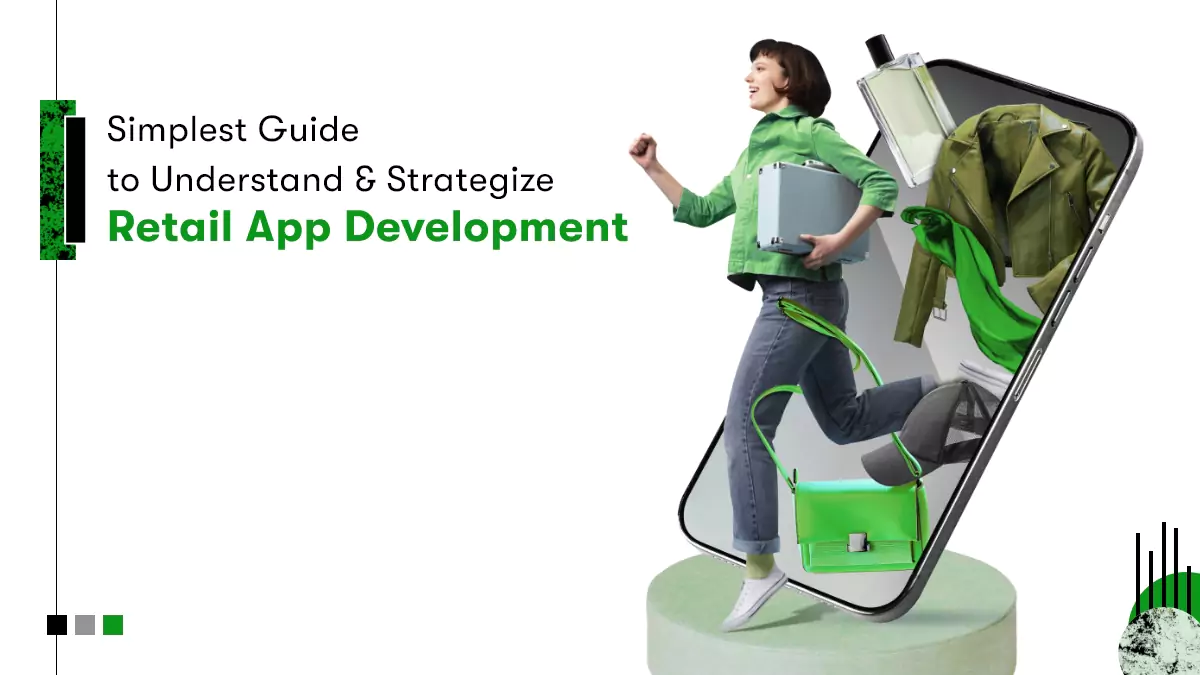
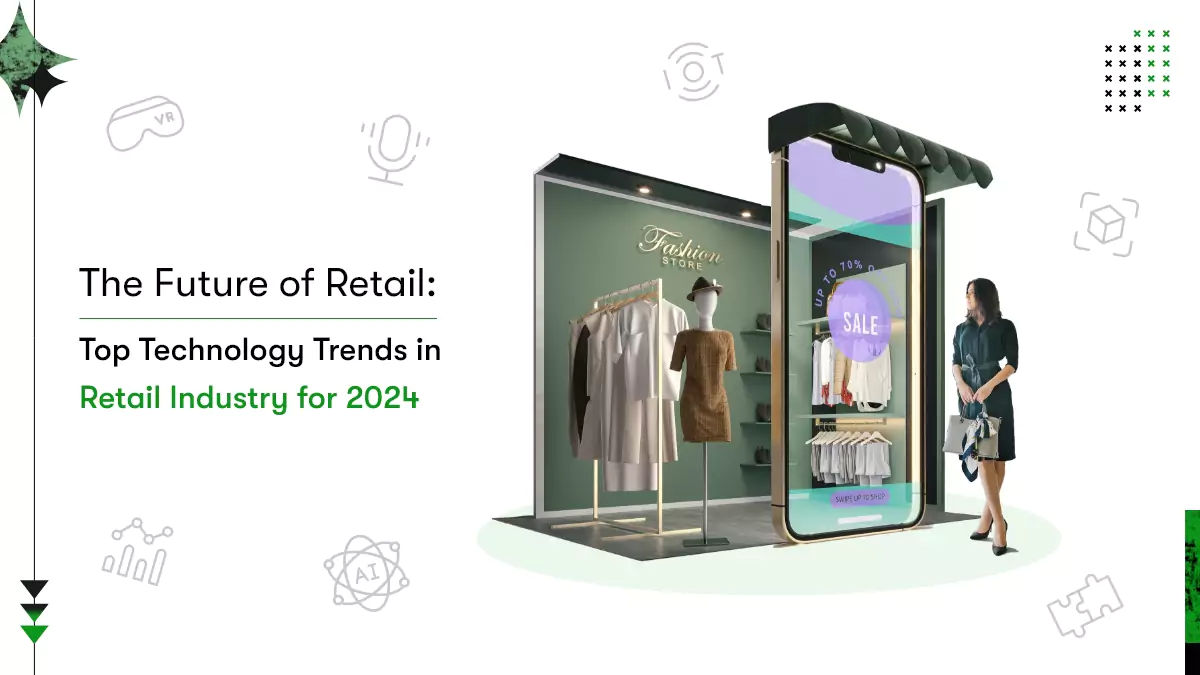






 Contact Information
Contact Information